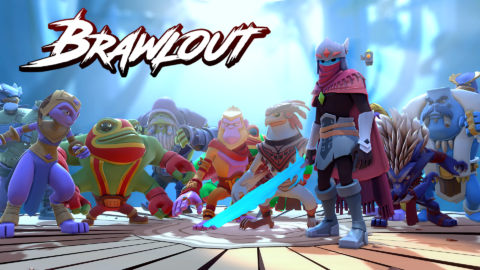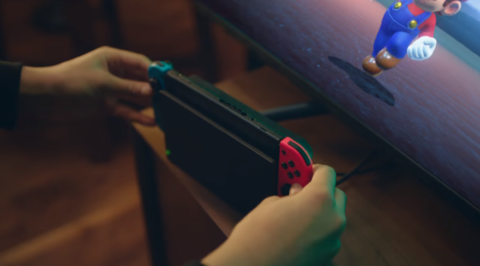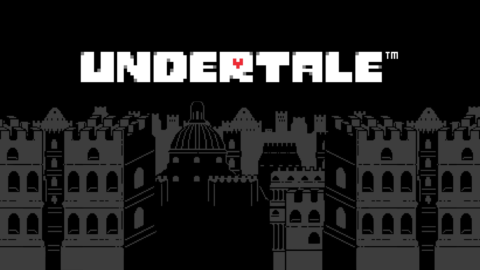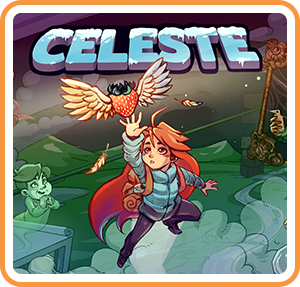
There’s something indescribably alluring about a good challenge. Little wonder that real climbers are constantly looking for the next big mountain, the next chance to push themselves further, and harder than before.
While you may not break a sweat tackling it, Celeste is certainly aware of our need for a mountain to climb. The latest quick-fire platformer from Towerfall: Ascension creator Matt Makes Games is all about the climb; the urge to go further, faster than before. Aside from that (and perhaps in connection with it,), it’s also about looking inside yourself for the resolve to go on, and sometimes…being afraid of what you find there.
Meet the Hikers
From the very beginning, Celeste does a fantastic job of setting a tone that drives the entirety of the game. Beginning with a minimalistic scene of driving snowfall, accompanied by the sound of a car pulling up and someone getting out, introduces us both to Madeleine’s impromptu decision to climb and to the isolation of the mountain itself.
Not long after the game begins, we’re introduced to the game’s sense of comedy, and its sense of foreboding. A small, awkward crow bounces and squawks around the first few boards as you get a feel for the controls. A strange old woman warns you that Celeste mountain is a strange place. As you run across an ancient bridge, it collapses beneath you. This isn’t gonna be easy, and it’s certainly not going to be boring.
I was pleased to find that overall, Celeste never really lets up in this nuanced presentation as you progress. Aside from the constant threat of death, I was beset on all sides by mystery and wonder. The set pieces are delightfully appropriate throughout, from snow-covered rises to rickety, abandoned buildings. There’s a constant sense that the mountain has lost something of its former glory, and it makes you want to go beyond the game’s core run-and-dash gameplay to find out just what on earth happened.
Celeste presents a beautiful backdrop, much the same as Towerfall: Ascension‘s brightly-colored arenas and menu boards. Once again, Matt Makes Games treats players to a delightful mix of vibrant pixel art in the main game and fully illustrated character art on dialogue boxes and chapter endings. Its an aesthetic that blends seamlessly and the amount of expression that this team can create from a somewhat basic pixel palette is truly impressive. The settings feel alive and believable, and the characters’ cartoonish faces peeking out from the frames during dialogue make them almost instantly loveable.
Adding to the game’s carefully crafted setting are characters that add just enough life to the desolate mountain to provide a good balance to the world. Each character is delightfully unique, with their own nuanced stories that unfold along with that of Madeleine, Celeste‘s darkly committed protagonist. A hiker with a curiously upbeat outlook on the climb, the strange shadow of Madeleine’s inner demons, and a ghostly but timid innkeeper are just a few of the players moving about the landscape.
The soundtrack and general audio in the game support all of its more prominent elements beautifully, and Celeste comes alive in handheld mode with a good set of headphones. The score is well aware of what’s happening on screen, accenting peaceful segments with serene piano music that ramps up to an intense pace in segments where the danger is high. All the while, the mountain howls mournfully and Madeleine’s dash sounds, climbing and labored breathing round out the experience.
The story of Celeste is perhaps the most pleasant surprise of the entire package. It keeps pace incredibly well with gameplay that would easily support a much more shallow presentation. It has an expertly crafted mix of self-reflection, endearing comedy and unsettling dark fantasy that feels reminiscent of films like Spirited Away. There’s a lot to love about the characters and the mountain itself that goes beyond the basics of completing levels as quickly as you can.
Hang on tight
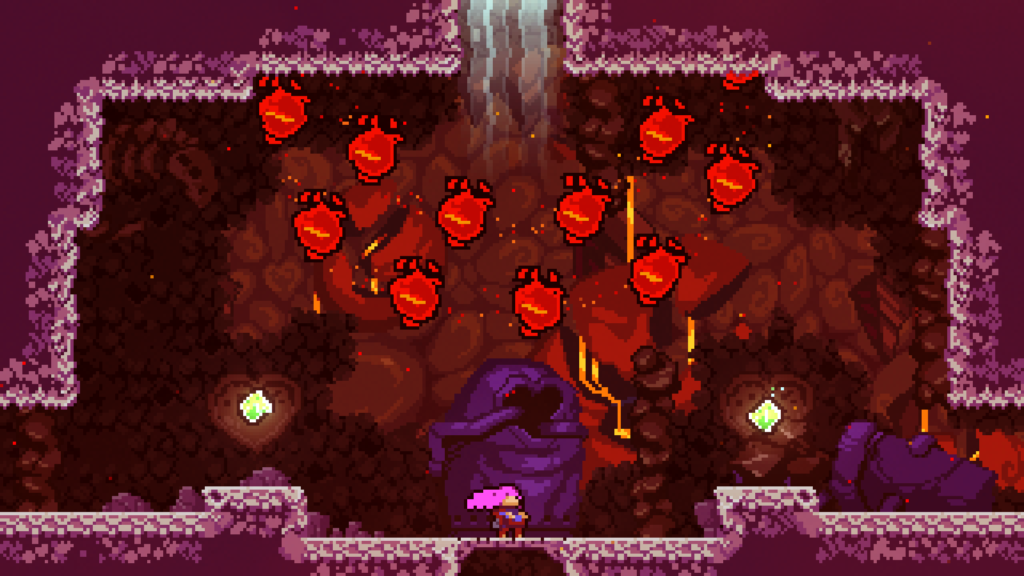
Despite the clearly enormous effort dedicated to giving players an immersive world and engaging story, Celeste is, at its core, a high-speed platformer built for one goal: dash through the world as quickly as you can, with as few mistakes as possible.
For its part, the overall gameplay loop is mercifully simple for how frustratingly difficult it is. Controlling Madeleine, players can jump and latch onto a wall to climb them provided they don’t have insta-kill spikes or other traps attached. Madeleine can dash in any direction once before needing to touch the ground to recharge. There’s also a “triangle jump” mechanic if you choose not to hold the climb button, which adds another option to shave off precious seconds from fluid sections of the wall.
We’ve seen quite a few games on the Nintendo Switch in particular that support the “speed runner” niche in different ways, but many such games seem to offer this option as something of an afterthought; crafting the core controls for casual play and then adding things that speedrunners can utilize. On the contrary, Celeste feels tailor made for those that prioritize speed and flawless runs.
Everything, from the quick resets after instant death to the clever shortcuts scattered throughout the levels is a testament to quick reflexes and constant, repetitious practice. The game doesn’t actually keep track of time by default, but there’s no denying that Celeste expects the utmost from us as players, subtly making the “again, faster” mentality omnipresent throughout. My best times only came after running specific sections quite a few times, and even then it proved uncommonly hard to complete significant stretches without quite a few resets.
The truth behind Celeste‘s punishing difficulty is that you almost can’t help but improve. The game is so tightly designed that I almost instantly recognized the bulk of my mistakes as my own, rather than some fault of the game or vague set of instructions. I did notice a few moments, where a lot of action hit the screen all at once, that generated some framerate drops that led to distracted deaths, but even these felt pretty quick to correct upon reset, and they rarely slowed me down for long.
While the controls don’t really evolve as you progress through Celeste, the challenges you face certainly do. As you climb higher through the more than 600 unique boards, the relatively tame spikes and moving platforms from chapter 1 become a pleasant (and distant) memory as you dodge poisonous blobs and help a crazy old ghost tidy up his sitting room. The progress feels natural, though, and doesn’t really introduce plateaus of difficulty that you might expect from such constant shifts in obstacles.
Punctuating each chapter is a rather novel approach to traditional boss fights. As I said before, setting a clock on the game is optional, and Celeste doesn’t overtly pressure you to complete levels in any specific amount of time…except for the ends of chapters. Players will encounter a different threat that chases them through the end sections of each chapter, constantly attempting to catch Madeleine as she rockets towards the end of the level. The challenge is roughly the same each time, but coupled with the aforementioned escalating obstacles and these bosses definitely ramp up the pressure in a sharp contrast to the rest of the game.
Overall, Celeste is tight, easy to pick up, and satisfyingly difficult to perfect. It will instill the expected (and perhaps desired) levels of frustration even in players familiar with ultra-hard games of its type, but the gameplay itself is so addictive that I had trouble staying mad at the game for long. The controls are equally satisfying in handheld as in docked mode, and the game ran consistently across both. It doesn’t seem that the Switch version offers any real advantage over other platforms here, aside from that built-in portability, but for that alone, I’d recommend heading to the eShop before you reach for a different platform.
Focusing on the climb

As much as there is to absorb about the rest of Celeste‘s core experience, the game is relatively light on extras and quality-of-life features. It isn’t hard to understand why, as the main portion of the game itself is satisfying with plenty of replay value that doesn’t really rely on extras to support it.
There are some collectibles scattered across the mountain, but they ended up being a pass for me the majority of the time. Strawberries float through many of the boards you’ll have to navigate, and you’ll have to get even more clever to gather them than you do to finish the stage itself. They add a nice upper level of challenge for those interested in tackling it, and it was a good call on the developers’ part to make them totally optional. However, the fact that they serve no purpose beyond bragging rights, they did make them feel less and less desirable to collect as the game went on, making me wish for some extra incentive to reach for them.
Aside from the strawberries, you can also collect rare “b-side” tapes in secret rooms that you’ll have to really look close to find. These are always stacked behind some uniquely challenging puzzle, and the soundtrack is solid enough that these at least have some value to collecting, but again it serves as little more than a brief distraction when the core game is so satisfying without the help.
The same goes for the delightful retro-inspired arcade machines that you can unlock, which offer up an even lower-resolution version of the game’s core mechanics as a sort of amusing side quest. Still, all of these little add-ins aside, it feels like the game would be so much better served (especially on the Switch) with a few extra features, like multiplayer races or built-in leaderboards for online competition.
Final Thoughts

While perhaps a little light on extras, and a little chopping in some places, Celeste delivers tight, white-knuckle thrills alongside beautifully introspective story and setting. This platformer is, simply put, gorgeous in its presentation from the vibrant pixel art of the core game to the endearing illustrations of characters and in-between panels.
There really is something here for everyone. Speedrunners should find plenty to love in Celeste, from the cleverly designed shortcuts to the nagging, subtle urge to collect everything. More casual players will appreciate the game’s choice to not force a breakneck pace all the time, and the chance to explore a world that holds more secrets than you’d expect.
Frustrating but exhilarating, poignant yet whimsical, Celeste is more than the sum of its parts. While the Switch version does little to set itself apart as this platformer’s definitive platform, you’ll be glad to have it on the go as much as on the couch. Because you know you can shave a few seconds off that last run.
Celeste is available now on eShop for $19.99 on Nintendo Switch.
Review Copy Provided by Matt Makes Games
